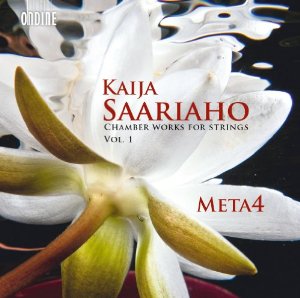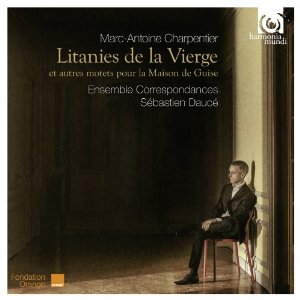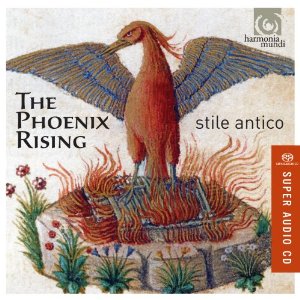|
You are reading the older HTML site
Positive Feedback ISSUE 69
Notes of an Amateur: Saariaho, Charpentier,
Stile Antico.
Kaija Saariaho, Chambers Works for Strings, Volume 1. META 4. Ondine ODE 1222-2.
In my simple (istic?) way of conceiving of modern music as a whole, probably iterated here too often, there is modernism, which seeks to take music onto new ground without breaking its connection to the tradition he seeks to reform. And there is avant-garde modernism, sometimes referred to as post-modernism (even in cases where it has preceded it! Berg and Webern), which aims to break the connection. To divert music around the tradition, subverting it in order to establish a more direct relation to our experience of the world. Avant-garde music tends to lose its sense of difference over time, but not all of it. Some threatens to stay out there in the future its creators imagined—on a permanent breakaway the tradition may never pull back. That is of course many avant-garde composers' dream. Finnish composer Kaija Saariaho, for all of her fame among contemporary avant-garde composers, requires great patience to appreciate from within the musical world we occupy and from which she strives to escape. Patience which is not always rewarded for some of us. Like many of her equally radical peers, she wanders on the outskirts of music where it overlaps with raw sound, asking instruments to express the unusual. She favors exquisite spiritual experience, sometimes bordering on pain—Tocar (2010), for violin and piano. Or wind-tortured, wind-haunted desert desolation bordering on nightmare -- Vent Nocturne (2009), for viola and electronics, in which the viola struggles to become recognizable music but continually collapses into defeat. Celices I, II, and III (2009), for violin and piano go after more complex experience. The first has a Middle Eastern quality but, as in Bartók, this suggested ethnic material is twisted and transformed into something abstract and, in her case, otherworldly. Celice II remains in the other world, whispering anxiously its unfathomable message. Celice III speaks louder but the language remains opaque. It is like being addressed with urgency in a foreign language by a spirit-like being. She squawks, sings, then turns away from us, distracted by her inability to communicate. Her 'song' becomes more of a private meditation. The Celices deserve further listening. Spins and Spells (1997) for cello solo shares some of the other works' otherworldly qualities but, perhaps because we are listening to a cello, it also has a peculiar earthly warmth. Still, like the others, it eludes us most of the time, refusing us more than an occasional melodic hook to grab onto that hints that here is a human heart beating in there somewhere calling us in. This is another Saariaho work that needs revisiting. Nocturne (1994) for violin solo is a brooder and a night wailer, a solo soprano voice in the dark with more painful, untranslatable secrets to tell. A celestial feline with issues only a feline has access to. (This is the kind of talk Saariaho's music induces in an amateur listener!) Which brings us to Nymphéa (1987) for string quartet and live electronics. In terms of length alone, this is the major work in the program. (21' 36"). It breaks no further new ground other than giving us a chorus of anxious otherworldly voices rather than solos. The "live electronics" amount to a breathy sound approximating voices joining in now and again. Nymphéa is the most hysterical work—in loudness and in its insistence to reach us. Listening to this long a stretch of Saariaho, I developed some greater degree of understanding for what she's about: she really does want to acclimate us to a different use for music. She wants to persuade us that the direct, unmediated apprehension of human reality is music's real calling. And because this is not something we are accustomed to, it will take some work on our part to get to a point where we can recognize reality presented in that way. That's what I meant earlier about "patience." And the "live electronic" voices are voices in Eliot's rose garden wooing us toward reality. Perhaps.
Marc-Antoine Charpentier. Litanies de la Vierge. Motets pour la maison de Guise. Ensemble Correspondances. Sébastian Daucé. Harmonia Mundi HMC 902169. The Phoenix is Rising. Stile Antico. Harmonia Mundi HMU 807572 Reviewing albums by these two groups offers the opportunity to compare them with two similar groups of the last generation, still both active but less so than during their respective primes. William Christie's Les Ars Florissants ruled the world of (mainly) French baroque vocal music in the 1980's, making some of the most engaging recordings of Charpentier in particular. Peter Philips' Tallis Scholars were equally dominant in English and European a cappella music of the renaissance. Enter the current generation's Ensemble Correspondances led by Sébastian Daucé, specializing so far (this is their third recording, first for HM) in the music of Charpentier; and leaderless Stile Antico, who have already achieved a seven-CD discography (all on HM) of mainly English renaissance a cappella music. It would be premature to call either of these two new groups successors to LAF or Tallis. Their styles are very different and to be generous, the world is big enough for all of them. Daucé's Ensemble approach Charpentier with more energy and less sensuality than Les Ars Florissants. Even the composer's Miserere is presented in what strikes me as a sprightly manner. Les Ars Florissants' deliberate and sensuous approach that I'm used to made the Ensemble's view seem frivolous at first; but the words they sing suggest that they have a point: "Make me to hear joy and gladness...Create in me a clear heart, O God, and renew a right spirit within me." The Ensemble's sound is eager and enthusiastic, almost secular, suggesting that secular and religious enthusiasm need not be so far apart as we often make them. Christie could be said to agree to some extent but LAF find the common ground in a quieter, lyrical lushness. What both groups clearly agree on is the priority of exquisite beauty. The Ensemble may move at a faster pace but the silver smooth sound of their viols, burnished warmth of their bass viols, warm and natural clarity of their higher voices and richness of the lower ones are all ravishing. There is no hint of northern European protestant reverence here! And the technical brilliance of the group gives their approach the authority excellence often brings. I have written in previous reviews of Stile Antico's work, their difference from their predecessors, the Tallis Scholars, is mainly to take a less ethereal, more earthy and direct view of renaissance a cappella music. This characteristic of their style is evident here as well. As I said earlier, they work without a leader, operating more like a string quartet, apparently collaborating on matters of interpretation. This album is essentially an anthology or sampler of English renaissance composers taken from Tudor Church Music (TCM), a ten volume collected edition of works by Tudor composers, published by Oxford U.P. between 1922 and 1929 in performing editions for use by choirs. The samples here are arranged as they might be for a concert. Short works by Tallis, Morley, Gibbons, White, and Taverner are arranged around and between sections of William Byrd's Mass for Five Voices. The program has the virtues and shortcomings of such an approach: it provides the breadth of a survey but does not let us focus for very long on any one composer—to be fair, including Byrd. By default, which may have been the producer's real goal (other than sampling TCM), we end up focusing on Stile Antico themselves. Stile Antico do not bring either drama or spirituality to this music. They simply sing it. They sing it well: voices are excellent and as an ensemble they have coherence and clarity. But it does feel more entertaining than involving or uplifting. They are a competent group, witness some of their other, more focused work. If what they do here is what you want and their approach as I describe it here sounds appealing, there you are. Equipment used for this audition: Resolution Audio Cantata CD player; Crimson 710 preamplifier and 640 amplifier; Tocaro 40 and 42 loudspeakers; Crimson cabling. Bob Neill is a former equipment reviewer for Enjoy the Music and Positive Feedback Online. He is currently proprietor of Amherst Audio in Amherst, Massachusetts which sells equipment from Audio Note (UK), Blue Circle (Canada), Crimson Audio (UK), Jean Marie Reynaud (France), Resolution Audio (US), and Tocaro (Germany).
|



